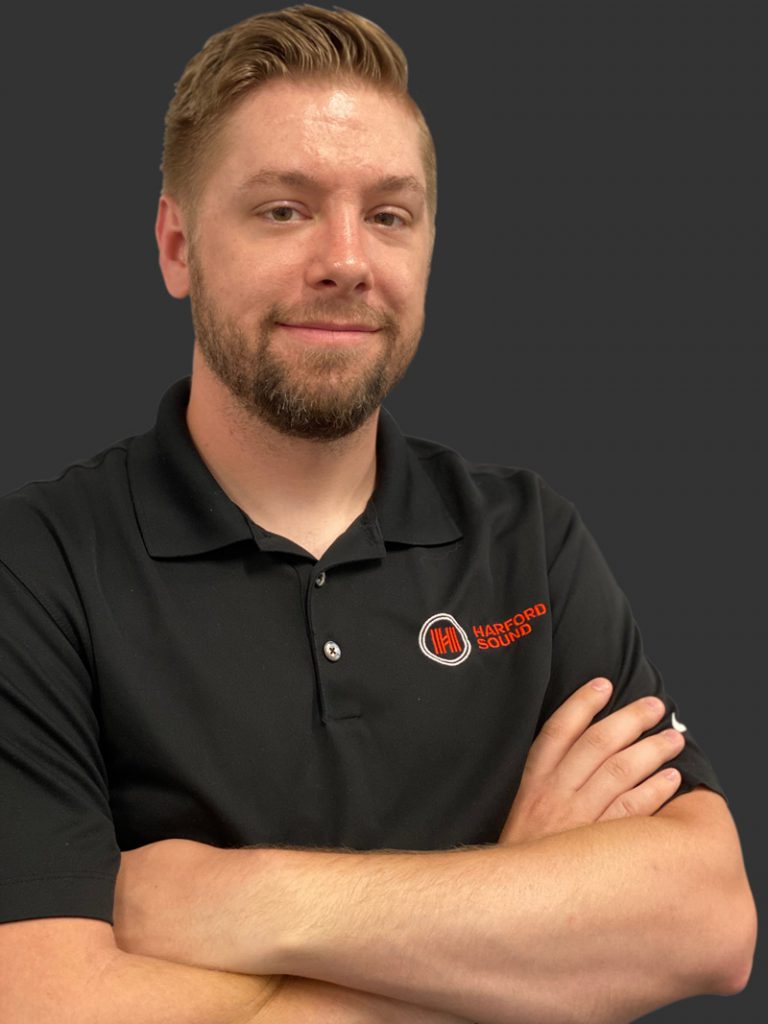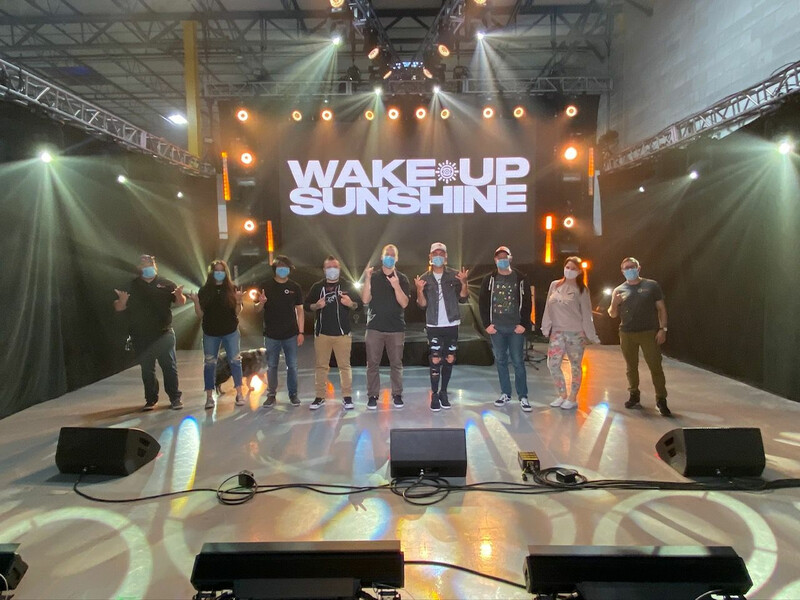Evan Kirkendall – Changing Light
Posted on July 6, 2020
Out of nowhere, like a rider in the night, change can swoop in and upend everything before we even fully grasp what has happened. Like everyone in the live event business, this production house entrepreneur experienced this unnerving sensation first-hand in the wake of the COVID-19 pandemic. Festivals like the Chesapeake Bay Blues, Preakness Infield and Firefly were canceled, as were dozens of other projects lined up for his Joppa, Maryland-based Harford Sound.
However, the same shockwaves that overturn existing plans also unearth new opportunities… And so, as Kirkendall contemplated the impact of the coronavirus, he vowed to do more than “just play spectator.” Like many of his peers, he began livestreaming during the earliest days of the lockdown, but rather than busying himself with limited productions, he opted to create a full-scale video and streaming studio with the idea of ultimately building it into a viable profit center.
Removing shelving from a 30’ by 25’ space of his 10,000 sq. ft. warehouse, he rigged it with 76 high output movers, blinders, uplights, and set pieces, as well as an advanced sound system and an 18’ by 10’ LED video wall. The result is a production studio that has been turning out two to three livestreams per week, in addition to selling promotional videos to bands and other clients. Thanks in part to this revenue stream, Harford Sound has been able to avoid furloughing any of its six employees during the pandemic.
 Kirkendall looks forward to the end of the lockdown, which he believes is coming in the not-too-distant future, so his company can once again work festivals and live music venues. When that happens, he still plans to offer livestream and video production services, since COVID-19, along with all the hardships it caused, has also opened the door to this long-term opportunity. Kirkendall talked to us about harnessing the power of change.
Kirkendall looks forward to the end of the lockdown, which he believes is coming in the not-too-distant future, so his company can once again work festivals and live music venues. When that happens, he still plans to offer livestream and video production services, since COVID-19, along with all the hardships it caused, has also opened the door to this long-term opportunity. Kirkendall talked to us about harnessing the power of change.
You devoted a great deal of space to your performance area and have rigged it up with a large number of fixtures and video panels. This is way larger than the average livestream studio that has cropped up in the wake of the lockdown. Did you decide to ‘go big’ right away? Or was this an idea that came to you gradually?
“This is ‘Rendition 2’ of our streaming rig. The first one was smaller, but still fairly fixture intensive. We wanted that ‘wow’ factor out of the gate, and once it became so popular, we took it up another notch.”
So, why did you decide to make such a major commitment to your performance space?
“There are two reasons. First, our gear is sitting and not doing anything else. Second, it’s a great opportunity for our guys to learn. Having this many fixtures up allows for our guys to come up with new looks, effects and color patterns between streaming. It’s been a great chance for everyone to sit down with the lighting console, program a show and expand our knowledge.”
Can you say what percentage of the work at your performance space is devoted to livestreaming shows as opposed to shooting promotional videos for bands that they will use to get future bookings?
“As of now, 99-percent of what we’ve done has been livestreaming shows. BUT, with that said, 100-percent of the acts have recorded their streams to use for future use. It’s kind of a two-for-one deal and great for the bands. They get to play a show to their fans and have some killer material they can chop up and use at a later date.”
How many people work for you? How many did you have to lay off because of the lockdown?
“We have six full time people here, and I’ve managed to keep everyone on this entire time. Between cash reserves, government help and the streaming, we’ve been staying afloat and don’t plan on going anywhere. It’s been detrimental for our freelance guys though – they haven’t seen a day of work since March.”
How do you promote your livestream and video recording service?
“It’s amazing how quickly things travel via word of mouth. We’ve done minimal advertising online, but embedding our logo on the stream has certainly helped drive business. Every time we do a stream, new people reach out the next day asking about our services. So, it’s kind of organically grown.”

How did bands respond to your offer to do this service?
“Again, it’s been a word of mouth and ‘seeing is believing’ kind of service. Once bands see other band’s performances, it just kind of takes off.”
You have obviously responded forcefully to the lockdown by going all out and creating a full production space, rather than retreating and waiting out the pandemic. What affect to do you think this decision will have on the course of your business and career after the pandemic is over?
“We have been doing what we can to stay relevant in the public’s eye. Staying with current trends and thinking outside of the box has kept us relevant and on top of the game. It’s always been our approach, and I think people will remember us once things pick back up.”
Speaking of when the pandemic is over, when and how do you see live tours and festivals coming back?
“People are dying to get back out to shows. 99% of the people I talk to would go to a concert tomorrow if it existed. I think things will ramp back up very quickly. The coming weeks are going to be the game changer for the remainder of the year. With all of the protests that have been happening, there’s no social distancing, no real precautions being taken. If COVID cases don’t spike, and hospitalizations remain fairly flat, I can’t see a reason for our industry to not return. As long as venues/festivals can offer extra sanitation steps, and temperature screening prior to entry, I think we’ll be in good shape.”
Do you think tours and festivals will be done differently because of what we’ve gone through with COVID-19?
“In the immediate future, yes. In the long-term, no. I think until a vaccine arrives, or the virus just plain disappears, masks will be a thing. The extra sanitation will be a welcome change though.”

In terms of your own business at Harford Sound, will you still be doing livestreams and video recording of shows even when live events return?
“We’re basically a full video production company now! We had to buy cameras and additional gear to do the streaming when this started, so we got to keep the gear working once things get back to normal!”
Before the pandemic, did you know much about streaming?
“We had been involved with some streaming previously, but we were never at the helm controlling things. We learned VERY quickly how to do it, what works, what doesn’t work and how to optimize things for streaming.”
Did you know much about videoing musical performances?
“Aside from watching concerts and other video guys in the past, nope! We all had to learn very quickly!”
How did you learn about these things?
“Our favorite way to learn: trial and error! Figure out what works, what doesn’t — and improve each time. We’re all self-taught and continue to learn every single day. If you look back at our first couple of streams, things have improved drastically since. We learned about camera lighting, color balancing cameras, framing the shots and basically everything a camera guy should know.”

What was the biggest challenge you faced establishing the livestream and video recording part of your business?
“Just building the infrastructure and learning about video. Our primary focus prior to COVID-19 was audio, lighting and staging. We had just bought into video at the end of 2019 with a video wall and some basic switching. We ramped up the rest of the stuff overnight and had to figure it out very quickly.”
What was the biggest lesson you learned from doing what you did since March?
“Things can drastically change overnight – and you have to be ready. If you sit back and wait, or just play spectator, you’re going to miss key opportunities, or someone else is going to beat you to the punch. You have to always be forward thinking and trying to stay ahead of the curve.”
If years from now, your grandchild asks you “What was it like living through the COVID-19 pandemic?” what will you say?
“Be happy you weren’t born back then!”